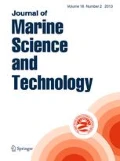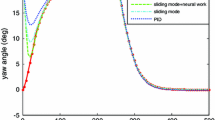Abstract
To resolve the severe wear problems of steering engine and fin stabilizer, the nonlinear response characteristics of steering engine and fin stabilizer are studied by analyzing sea trial data of ship Yukun. The nonlinear response characteristics are summarized and applied to a rudder and fin hybrid control system. Decoupling, \(\hbox {H}_\infty\) and \({\rm H}_2\) controllers are designed to achieve low control frequency for it. Simulations show that all the three controllers can achieve excellent course-keeping and roll damping performances, and their control frequencies and amplitudes are consistent with those of nautical practice. It can be found that \(\hbox {H}_2\) controller achieves the best response performance of course-keeping and energy saving performance for rudder engine; \(\hbox {H}_\infty\) controller achieves the best response performance for roll damping; Decoupling controller has the best energy saving performance for fin stabilizer. When the Beaufort wind force scale is increased from 6 to 8 and model perturbation is involved, \(\hbox {H}_2\) controller shows the best robustness of control performance and control input. In addition, the designed low-order controllers can reduce hardware cost for autopilot realization in nautical field.














Similar content being viewed by others
Abbreviations
- \(N_\delta\) :
-
Total number of steering
- \(M_\delta\) :
-
Averaged steering amplitude
- \(\psi\) :
-
Heading angle
- \(\psi _\varDelta\) :
-
Changed heading angle
- \(n_\delta\) :
-
The number of steering
- \(m_\delta\) :
-
The amplitude of steering
- \(T_\mathrm {c}\) :
-
Time of sea trial
- \(m_\delta\) :
-
The amplitude of steering
- \(\phi\) :
-
Roll angle
- \(\delta\) :
-
Rudder angle
- \(\sigma\) :
-
Fin angle
- u :
-
Surge speed
- v :
-
Sway speed
- \(\tau\) :
-
Steering period
- r(t):
-
Input signal
- e(t):
-
Error signal
- \(J_E\) :
-
Objective function
- \(V_\mathrm s\) :
-
Ship speed
- \(V_\mathrm R\) :
-
Relative wind speed
- \(\psi _\mathrm R\) :
-
Relative wind direction
- \(V_\mathrm {w}\) :
-
Absolute wind speed
- \(\psi _\mathrm {w}\) :
-
Absolute wind direction
- \(V_\mathrm {c}\) :
-
Absolute current speed
- \(\psi _\mathrm {c}\) :
-
Absolute current direction
- \(\delta _\mathrm {wind}\) :
-
Rudder angle induced by average wind
- \(W_\mathrm {c}\) :
-
Second-order oscillation system
- G :
-
Controlled plant
- D :
-
Decoupling controller
- K :
-
\(\hbox {H}_\infty\) controller
- Q :
-
\(\hbox {H}_2\) controller
- A :
-
System matrix
- B :
-
Control matrix
- C :
-
Measurement matrix
- U :
-
Input matrix
- s :
-
Laplacian operator
- \(S_{\psi }\) :
-
Desired heading
- \(S_{\phi }\) :
-
Desired roll angle
- \(T_{\psi }\) :
-
Actual heading
- \(T_{\phi }\) :
-
Actual roll angle
- \(U_{\delta }\) :
-
Input rudder angle
- \(U_{\sigma }\) :
-
Input fin angle
- \(A_{\psi }\) :
-
Mean absolute error of heading
- \(A_{\phi }\) :
-
Mean absolute error of roll damping
- \(I_{\delta }\) :
-
Mean absolute input of rudder angle
- \(I_{\sigma }\) :
-
Mean absolute input of fin angle
- O-\(X_0Y_0Z_0\) :
-
Space fixed coordinate system
- \(x_0\),\(y_0\) :
-
Ship position
- o-xyz :
-
Body fixed coordinate system
- CFD:
-
Computational fluid dynamics
- MIMO:
-
Multi-input multi-output
- SISO:
-
Single input single output
- RGA:
-
Relative gain array
- RHP:
-
Right half plane
- MPC:
-
Model predictive control
References
Chang CM, Chang WJ, Ku CC et al (2018) Passive fuzzy control for lift feedback fin stabilizer systems of a ship via multiplicative noise based on fuzzy model. J Marine Sci Technol 26(2):159–165
Zhang ST, You PP, Zhao P et al (2019) Experimental study on the control form of fin stabilizer at zero speed. Plos One 14(5):1–21
Liang LH, Wen Y (2019) Rudder roll stabilization with disturbance compensation model predictive control. J Marine Sci Technol 24(1):249–259
Chang CM, Chang WJ (2019) Robust fuzzy control with transient and steady-state performance constraints for ship fin stabilizing systems. Int J Fuzzy Syst 21(2):518–531
Liang LH, Sun MX, Shi HY et al (2017) Design and analyze a new measuring lift device for fin stabilizers using stiffness matrix of euler-bernoulli beam. Plos One 12(1):1–21
Fang MC, Luo JH (2005) The nonlinear hydrodynamic model for simulating a ship steering in waves with autopilot system. Ocean Eng 32(11):1486–1502
Irkal MA, Nallayarasu S, Bhattacharyya SK (2019) Numerical prediction of roll damping of ships with and without bilge keel. Ocean Eng 179:226–245
Perez T, Blanke M (2012) Ship roll damping control. Annu Rev Control 36(1):129–147
Kianejad SS, Enshaei H, Duffy J et al (2019) Prediction of a ship roll added mass moment of inertia using numerical simulation. Ocean Eng 173:77–89
Hirakawa Y, Hirayama T, Kakizoe K et al (2014) Sea trial of prototype vertical weight stabilizer (vws) anti-rolling system for small ships. J Marine Sci Technol 19(3):292–301
McCue L (2016) Handbook of marine craft hydrodynamics and motion control [bookshelf]. IEEE Control SystMag 36(1):78–79
Perez T, Goodwin G (2008) Constrained predictive control of ship fin stabilizers to prevent dynamic stall. Control Eng Pract 16(4):482–494
Amerongen JV, Klugt PV, Lemke HV (1999) Rudder roll stabilization for ships. Automatica 26(4):679–690
Zhang ZH, Zhang XK (2019) Controller design for mimo system with time delay using closed-loop gain shaping algorithm. Int J Control Auto Syst 17(6):1454–1461
Wang XP (2009) Simple and direct nonlinear robust control of rudder/fin joint system. PhD thesis, Dalian Maritime University
Davison JE (1966) A measurement of the heat capacity of camg2 and a calculation of the cohesive energy of camg2. PhD thesis, Iowa State University
Carlberg K, Farhat C, Cortial J et al (2013) The gnat method for nonlinear model reduction: effective implementation and application to computational fluid dynamics and turbulent flows. J Comput Phys 242:623–647
Mo R, Li M, Kang HG (2018) Transient behaviour of grouted connections of offshore wind turbines subject to ship impact. App Ocean Res 76:159–173
Zhang ZH, Zhang XK, Zhang GQ (2019) Anfis-based course-keeping control for ships using nonlinear feedback technique. J Marine Sci Technol 24(4):1326–1333
Kallstrom CG (1979) Identification and adaptive control applied to ship steering. PhD thesis, Lund Institute of Technology
Zhang XK, Yang GP, Zhang Q et al (2017) Improved concise backstepping control of course keeping for ships using nonlinear feedback technique. J Navig 70(6):1401–1414
Puga S, Bonilla M, Malabre M et al (2016) Singularly perturbed implicit control law for linear time-varying delay mimo systems. Int J Robust Nonlinear Control 26(7):1395–1421
Koshkouei AJ, Nowak L (2012) Stabilisation of ship roll motion via switched controllers. Ocean Eng 49:66–75
Zhang WD (2011) Quantitative process control theory. CRC Press, Boca Raton
Zhang XK, Zhang GQ (2016) Design of ship course-keeping autopilot using a sine function-based nonlinear feedback technique. J Navig 69(2):246–256
Author information
Authors and Affiliations
Corresponding author
Additional information
Publisher's Note
Springer Nature remains neutral with regard to jurisdictional claims in published maps and institutional affiliations.
About this article
Cite this article
Zhang, Z., Zhang, X. Course-keeping with roll damping control for ships using rudder and fin. J Mar Sci Technol 26, 872–882 (2021). https://doi.org/10.1007/s00773-020-00779-6
Received:
Accepted:
Published:
Issue Date:
DOI: https://doi.org/10.1007/s00773-020-00779-6




